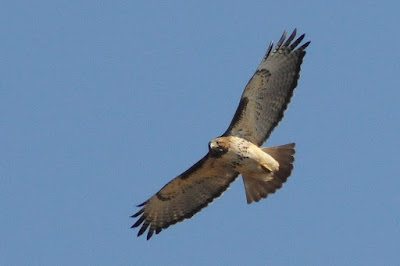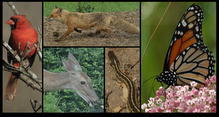Birds-in-Flight: Red-Tailed Hawk







Wildlife observations from a suburban backyard adjacent to the Colvin Run Mill Park in Vienna, Virginia. Click on photos to enlarge.







Posted by
Gil Miller
at
6:48 PM
![]()
Labels: Flight, Red-tailed Hawk

This work is licensed under a Creative Commons Attribution-NonCommercial 3.0 License.

Gil - these are unbelievably good pictures!
ReplyDeleteGreat shots. I tried to get close to these with not so stellar (to put it mildly) results:
ReplyDeletehttp://owlbox.blogspot.com/2008/02/kiss-my-flying.html
The shot of the Downy in flight is off the charts - well done! BTW, what lens are you using for these photos?
First, I beleive that getting birds, especially small birds, in flight involves a lot of luck. Second, there are a few things that I use:
ReplyDelete>For all but the raptors, you will not capture the bird in flight unless you get them from a perched start.
>Anticipate which direction the bird will begin to fly (for example, from the feeder to the favorite tree)
>Do not start with the bird in the center of the photo. Rather, put the bird in a perched position on the right or left extreme of the photo and let the bird fly into your shot.
>Anticipate when the bird will launch
>Then, start shooting with continuous shooting (multiple shots in a few seconds)
>Pre-focus and pre-meter as best possible. I have had little luck with continous auto-focus and auto-exposure.
>With the raptors, you are more likely to only get them in flight (not from a perched start). In this case, you get one auto-focus. If you are good, then perform manual focus. The above and a lot of luck might get you a bird in flight.
The DSLR I recently purchased (a real splurge) and am currently using is a Nikon D300. Speed goes to 6400 ISO with surprisingly good noise performance. That allows high shutter speed which in turn enables you to use a telephoto lens without tripods, especially in good sun light. All of my hawk photos are significantly cropped, helped by the 12 M pixels. Lens is a Nikon 70-300mm zoom that I already had. As the camera sensor is not full frame, the effective lens is 105-450 mm, which is about the minimum required for birds. The 70-300mm now comes in a VR - vibration reduction - version which improves performance enven more. Also, the modern DSLRs allow for continuous shooting (multiple shots in a few seconds).
By the way, the Nikon D300 is a great camera, but it came out of the box with a hot pixel - a default. Neither Nikon or Amazon.com are willing to replace the unit. If you are purchasing the D300 I strongly suggest that you purchase it locally so you can see performance before you buy.
Owlman, if only I could find some owls - lucky you to have them around. Now getting an owl in flight, that is a dream shot!
Thanks for the tips Gil. In reality I think the issue of capturing the bird is related mostly to experience and shutter release delay. I'm using a digitial rebel and it isn't exactly snappy. Still with practice I think I will get better.
ReplyDeleteMuch like taking bird photos in flight, finding owls also takes patience, perseverance, time, hard work and a boat load of good luck. Owls are everywhere you just need to know where to look and you need to take the time to search. I spent much of last Saturday looking for Saw Whet with no luck. I'm hoping that I get lucky later this week.